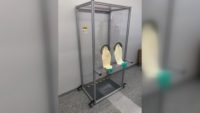DETROIT—With ventilators and face masks now in production, GM is expanding its manufacturing of personal protective equipment, including latex-free face shields, protective gowns and aerosol boxes. All of these supplies are being donated.
These projects have been led by employee volunteers looking to apply their automotive-production skills—from 3D printing to sewing upholstery—to help those on the front lines of the coronavirus pandemic.
Initially, these projects were grassroots efforts, with employees delivering handmade samples to hospitals for feedback and tweaking prototypes based on feedback, which fed into the final designs.
Today, with the help of suppliers, GM will apply its scale and manufacturing capabilities to amplify these efforts, mass-producing up to 50,000 face masks per week, and ramping up production of protective gowns and aerosol boxes.
“It’s amazing how much our employees have accomplished in such a short time,” says Mark Reuss, GM president. “People from all corners of the company have really stepped up to help, and to lend their talents, time and energy to battle coronavirus.”
GM is coordinating with the State of Michigan’s personal protective prioritization team to identify which hospitals in the state need face shields most urgently. GM employees are delivering protective gowns to hospitals in the Henry Ford Health System and aerosol boxes to other area healthcare facilities.
Face Shields
GM’s Additive Manufacturing and Design Fabrication Operations teams first discussed making protective face shields on Monday, March 23. By 4 p.m. on Friday, March 27, the teams had reached consensus on a design and started manufacturing their first shields that evening.
Components of the first face shields were 3D printed at five GM locations—three onsite at the Global Technical Center in Warren, MI, one at the Milford Proving Ground in Milford, MI, and one at the North Hollywood Advanced Design Center in North Hollywood, CA.
Depending on the location and 3D printing technology used, the shield visors were printed from three different types of material, including:
- Acrylonitrile styrene acrylate for FDM printers.
- DuraForm PA polyamide nylon plastic for SLS printers.
- Accura Xtreme Gray for SLA printers.
The shields were cut from clear 0.7-millimeter polyester sheets on an Eastman Machine Co. M9000 static table cutting system that is normally used to cut trim pieces for concept vehicles.
“3D printing allowed us to react quickly to the need for face shields and get initial units to people on the front line almost immediately,” says Steve Hart, GM director of design fabrication operations. “3D printing did exactly what it’s intended to do—it let us get a proof of concept and initial production off the ground and make incremental improvements based on recipient feedback prior to mass production.”
For full production, GM is collaborating with suppliers, including Summit Polymers of Kalamazoo, MI. Summit Polymers donated a P20 steel injection mold that will enable GM to increase production from roughly 4,000 to 25,000 units per week. GM is purchasing a second injection mold to help increase production up to 50,000 units per week.
Summit Polymers plans to donate the first 100,000 face shield components it makes to GM.
“We worked with a local shop, S&K Tool & Die, to rapidly design and develop the mold to make the visors that hold the shields in place,” says Jody Flinton, general manager of Summit Polymers Plant 18. “Summit is proud to support GM in the effort to help save lives in our community and help keep our healthcare heroes safe.”
The actual shields are made from polyethylene terephthalate (PET) by Argent International of Plymouth, MI. Argent International is also making the 12-inch elastic bands that hold the shields in place. The company will donate the first 2,500 shields to GM.
Shield components will be shipped from Summit Polymers and Argent International for final assembly to the GM facility in Warren that is also making face masks and filtering face-piece respirators. Once assembled, the face shields will be shipped to high-priority hospitals in Metro Detroit in cases of 100, as directed by the State of Michigan’s Personal Protective Equipment List.
Protective Gowns
Under ordinary circumstances, GM’s fabrication organization—which includes metal, paint, trim, wood, mold and plaster teams—creates one-of-a-kind parts and vehicles, like show cars. Today, the skilled tradespeople from UAW Locals 1869 and 160 who make up these teams are assembling protective gowns and aerosol boxes at the Warren facility.
“Our team members are experts at solving problems on the fly and creating things from scratch,” says Hart. “The dedication, abilities and spirit of collaboration from our skilled tradespeople has been humbling. They are working longer hours than ever on a voluntary basis to fulfill urgent requests from doctors, nurses and other professionals on the front lines.”
Skilled tradespeople from the color and trim departments sewed sample protective gowns that were distributed to local hospitals for evaluation. The first prototypes were made from old car covers to perfect the pattern.
The final gowns approved for use have been sewn from Tyvek supplied by Henry Ford Health System, are lightweight (approximately 2 ounces), breathable and protective. The completed gowns are being delivered directly to HFHS by GM employees.
Aerosol Boxes
Local hospitals are also in critical need of aerosol boxes, see-through containers that protect medical personnel while they are intubating patients. GM’s design fabrication team came up with an initial concept, demonstrated it with local intensive care personnel, and used their feedback to come up with a design that is now being distributed to local hospitals.
GM’s aerosol boxes measure 20 inches high, 20 inches wide and 16 inches deep, with arm holes on the side to help protect doctors while treating patients. These boxes are hand-formed on a heat bar from polyethylene terephthalate glycol-modified sheets in quantities of 40 to 46 per day.


